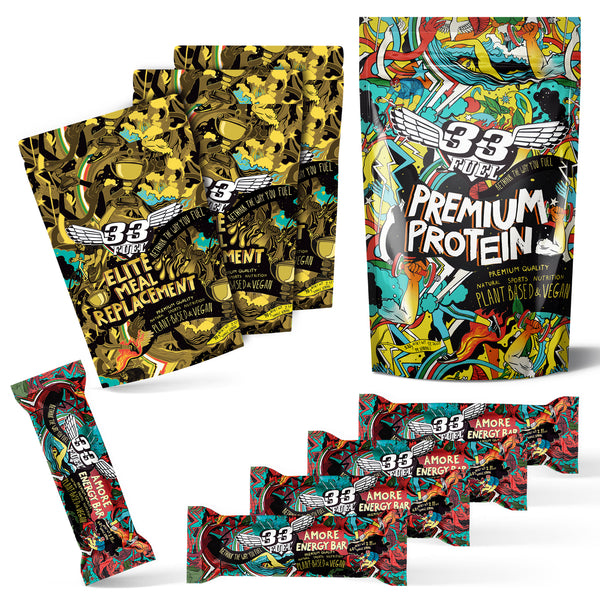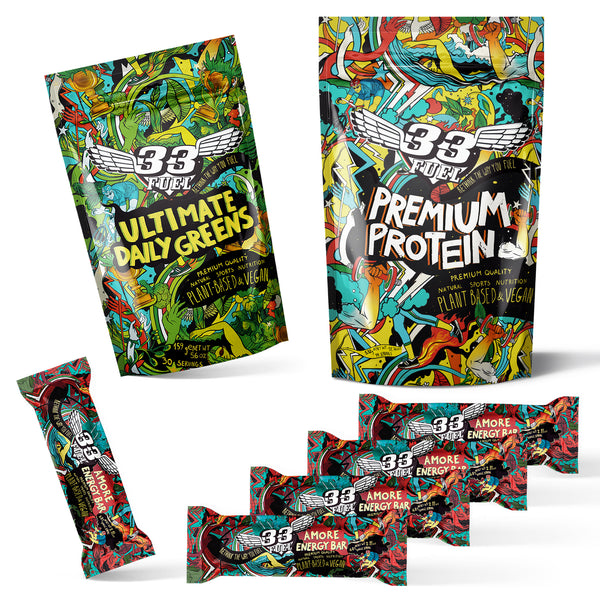10 Easy Training Mistakes To Avoid

Google 'how to train for X' [whatever your event] and you’ll be shown countless methods with arguments for and against various training systems. It’s your job to work out which best fits your life, starting point and goals. Even though there's many different paths, here's 10 easy training mistakes to avoid
Mistake #1: You don’t train hard enough
Most of us love to long, steady (aka slow) miles! Whatever your sport, being ‘out there’ is all part of the pleasure, and logging easy miles is just dreamy. Plus, the demands of longer events requires us to be able to develop an ability to endure mental fatigue and physical discomfort. To develop this ability, we need to log long training hours.
Shop our award-winning sports nutrition
Best Sellers
But many place 100% of their focus on this and no time towards higher intensity training. It may only comprise a small proportion of your overall schedule, but there’s a tonne of research showing how upping the ante now and again brings great gains for all types of athlete.
Mistake #2: You don’t train easy enough
Flying in complete disregard of my previous point, there are many amongst us who simply train too hard too often. We all know that person: the highly motivated yet slightly misguided bloke (let's be honest, it's always a male - women have more sense) at the running club who smashes himself to pieces even on the ‘steady social’ session. While his enthusiasm might be admirable, give him a tap on the shoulder and explain that slowing down a tad will probably result in greater gains.

Ready to sprint? On your easy days, go easy so that when you need to go hard, you can
Mistake #3: You ignore recovery
Recovery is a huge topic in its own right but for now I just want to get across one message - recovery is of utmost important.
Further, a multi-faceted approach to recovery is needed. You might neck that protein shake within 30-minutes of training, but if you're then going to stay up late boozing then that shake is largely nullified. Recovery is all about ticking small boxes consistently, such as:
- Post-workout nutrition – go for whole food where possible and if you’d rather a shake, make sure it’s made with real food and contains at least 20g protein, like Premium Protein
- Sleep – there’s a few tips and tricks on our guide to better sleep for athletes which should help you out
- Stress – stress floods your body with cortisol - a performance wrecking ball. Adding just 10 minutes each day of mindfulness practice has been shown to reduces stress, anxiety and depression and will thus contribute to better recovery
- Eat well – as we noted above, there’s no point necking a healthy shake post-workout if the rest of your diet isn’t up to scratch. Aim for great eating habits 80% of the time and let things relax the other 20%
- Take a cold shower – yep, there’s a lot of benefits to a cold shower
We are good at pushing ourselves, but not so good at looking after ourselves. An efficient immune system will fend off viruses and maintain training consistency – bolster yours with one daily spoonful of nutrient-dense Ultimate Daily Greens
Mistake #4: You don’t pay attention to your immunity
Many of us love pushing boundaries and often need holding back more often than a kick up the rear. This is a great trait but regularly stressing our body means we compromise immune function. Fortunately, it’s a simple one to get right.
Our Ultimate Guide to Immune Function & Training covers everything you need to know on this topic, but in short there are four key factors which impact the efficiency of your immune system:
- Nutrition
- Exercise
- Sleep
- Stress
Your diet is the factor which impacts the immune system the most - what you eat seriously impacts your immunity - so if you go big on fast food, junk and sugar, you’ll compromise its efficacy.
Kombucha is a great source of probiotics – check out this new range of probiotic water from Hanora Health
What’s crucial here is the role the gut plays on immune function. The health of the gut is intricately linked to immune function and the health of your gut is a product of the food you eat.
Happy gut = bolstered immunity = happy athlete.
Even oral health is important. One piece of research showed a whopping 33% of athletes “experience disrupted training and poor performance as a result of bad oral health” despite good cleaning habits (the culprit here is sports nutrition high in sugar and chemicals).
Mistake #5: You’re hooked on stats
Who doesn’t love stats? We all train to improve – using whatever markers are relevant and motivating to you – but because of that we often get too wrapped up in stats. Logging training is key to identifying strengths, weaknesses and positive / negative trends and are thus useful for directing and measuring training. But doing so alongside listening to your body is crucial.
Sometimes the stats don’t give the full picture and focusing too heavily on them can result in a downward trend – both physically and mentally. Being driven 100% by stats means you’re not truly hooking yourself into.
At the other end, some days you’ll head out for an easy run only to feel like a caged lion, champing at the bit to unleash a rocket. That’s fine too – listen to your body and go for it!
In both instances, by listening to your body you’ll change the session to account for (and capitalise upon) life’s fluctuations rather than rigidly sticking to data-driven training.
Tracking progression needs to be multidirectional. Monitor HR, power, pace and whatever other quantitative data you gather. But also pay attention to RPE, your mood, stress and other life factors. Bring them together and use a combination of these to guide your training.
Mistake #6: You’re not consistent

That feeling when you hit the training sweetspot. Enough to bring about gains but not too stressful for burnout. It feels great once you find it
Consistency is king. A bit like the hare we met earlier who thrashes himself at every easy club run, the same individual is often missing from other sessions due to injury, burnout or desertion of mojo (again, this runner is usually a male!).
Ask any pro athlete and they’ll put consistency in their top three necessities for successful development. Consistency is individual – it could be two sessions a week or twelve – but it’s all the same: do the work week in, week out without any huge peaks or troughs and you’ll progress.
Of course, periods of harder training followed by periods of recovery are needed (see ‘You don’t periodise your training’ below) but there’s a big difference between structuring this and being at the mercy of inconsistency.
Mistake #7: You don’t set goals
I actually believe most of us are particularly good at goal setting, but some still doubt the value of it.
Underpinning the questioned need for a goal is: how do you know if you’re going in the right direction if you don’t know where you’re hoping to end up?

…but don't forget to plan for it!
Most of us enter races or set our own challenges while others have a goal of losing weight or getting lean. But few spend much thought on the goal setting process and often don’t maximise its potential. Set correctly, a goal provides purpose, direction, motivation and a sense of achievement when reached (or information on how to do things differently if not).
Knowing how to set goals is important – finding the difference between unrealistic and ambitious can be tricky – but it’s a worthwhile exercise for any endurance athlete.
Mistake #8: You don’t periodise your training
Periodisation is the process of dividing a full training plan into shorter phases in which you place more emphasis on one aspect of training over another. The classic periodisation model, for example, may look something like this:
- Phase 1. Build a solid aerobic base
- Phase 2. Add volume and incorporate strength training
- Phase 3. Build intensity and add specificity
- Phase 4. Peak volume block
- Phase 5. Reduce volume and continue some intensity tapering towards event.

Periodizing your training means varying the volume and intensity of your training depending on the phase you’re in
Within each phase you’ll have weeks which build volume and stress followed by weeks / days of recovery. It’s this stress and recovery cycle that results in development.
Periodisation often evades athletes who simply want to swim / bike / run / train more and more without much of a plan. It doesn’t need to be complex - just make sure you’re alternating periods of stress with periods of recovery, both on a micro (daily & weekly) and macro (monthly & yearly) level – but doing so will help hugely.
Mistake #9: You don’t fuel like an endurance athlete
When it comes to fuelling pre-, post- and mid-training, endurance athletes often focus too narrowly on high sugar, carb-laden sports nutrition. While this was the done thing in the 80s and 90s, we know better now.

Elite endurance athletes fuel with real, wholesome food
Elite athletes focus on whole, real food and bars and gels with less processing than was the norm couple of decades ago. This article isn’t about pulling apart ordinary sports nutrition – we’ve other articles about maltodextrin, potassium sorbate and sodium benzoate – but rather to get across a broad message: go real food. Whether you’re looking to buy bars, gels, shakes, whatever, look at the ingredients label.
If it reads more like a chemistry set, then you may want to think twice. Go for nutrition which has pronounceable, nutrient-dense ingredients – it’ll not only fuel your endurance feats more effectively but also improve your health too.
Mistake #10: You don’t do strength training
We want to be lean endurance bunnies and avoid carrying any excess weight and thus avoid the gym like the plague. After all, muscle harms endurance performance, right? Wrong!

No, strength training doesn’t mean doing bicep curls or getting ‘hench’
95% of endurance athletes do too much cardio to build muscle.
Look at Mo Farah – you wouldn’t know it looking at him but he smashes it in the gym and lifts heavy weights. Unless you significantly reduce your endurance miles and start making a serious dent in the poultry population with your protein consumption, you will not bulk up from adding a couple of strength training sessions per week.
5 strength training myths BUSTED
If (when!) you start adding strength training into your schedule, you can expect to see economy, power, strength improve and injury occurrence decrease. But make sure you’re doing it right. Lift heavy, complete all-body compound moves and recover properly. You’ll start seeing gains real quick once you start doing this.
Adequate protein intake is cruical for optimal recovery. But avoid the sugar-laden, heavily processed whey protein that compromises health and immune function. Go instead for a 100% natural plant-based powder with 20g protein per serving
More performance boosting content
From the Vlog – Strength, power and training smart with Brian Keane
From the Podcast – Gut health 101 with Ross Austen
From the Blog
Best snacks for endurance athletes
5 game changing benefits of pea protein
Goal setting – 7 ways to achieve big dreams
Strength training for marathon runners












